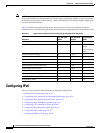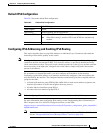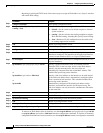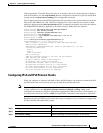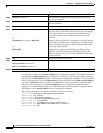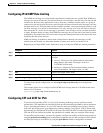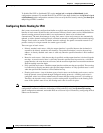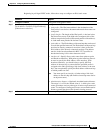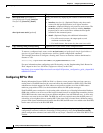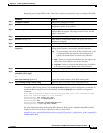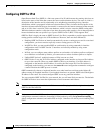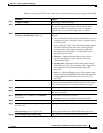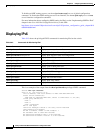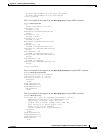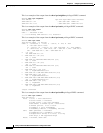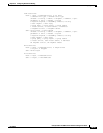
39-18
Catalyst 3750-E and 3560-E Switch Software Configuration Guide
OL-9775-02
Chapter 39 Configuring IPv6 Unicast Routing
Configuring IPv6
To remove a configured static route, use the no ipv6 route ipv6-prefix/prefix length {ipv6-address |
interface-id [ipv6-address]} [administrative distance] global configuration command.
This example shows how to configure a floating static route to an interface with an administrative
distance of 130:
Switch(config)# ipv6 route 2001:0DB8::/32 gigabitethernet2/0/1 130
For more information about configuring static IPv6 routing, see the “Implementing Static Routes for
IPv6” chapter in the Cisco IOS IPv6 Configuration Library at this URL:
http://www.cisco.com/en/US/products/sw/iosswrel/ps5187/products_configuration_guide_chapter0918
6a00801d7f7d.htmll
Configuring RIP for IPv6
Routing Information Protocol (RIP) for IPv6 is a distance-vector protocol that uses hop count as a
routing metric. IPv6 RIP functions the same and offers the same benefits as RIP in IPv4. IPv6 RIP
enhancements include support for IPv6 addresses and prefixes and the use of the all-RIP-routers
multicast group address FF02::9 as the destination address for RIP update messages.
Each IPv6 RIP process maintains a local routing table, referred to as a Routing Information Database
(RIB), that contains a set of best-cost IPv6 routes learned from all its neighboring networking devices.
If IPv6 RIP learns the same route from two different neighbors, but with different costs, it stores only
the lowest-cost route in the local RIB. The RIB also stores any expired routes that the RIP process is
advertising to its neighbors that are running RIP. If the same route is learned from a different routing
protocol with a better administrative distance than IPv6 RIP, the RIP route is not added to the IPv6 RIB,
but the route still exists in the IPv6 RIP RIB.
Note Before configuring the switch to run IPv6 RIP, you must enable routing by using the ip routing global
configuration command, enable the forwarding of IPv6 packets by using the ipv6 unicast-routing
global configuration command, and enable IPv6 on any Layer 3 interfaces on which IPv6 RIP is to be
enabled.
Step 4
show ipv6 static [ipv6-address |
ipv6-prefix/prefix length] [interface
interface-id] [recursive] [detail]
or
show ipv6 route static [updated]
Verify your entries by displaying the contents of the IPv6 routing
table.
• interface interface-id—(Optional) Display only those static
routes with the specified interface as an egress interface.
• recursive—(Optional) Display only recursive static routes. The
recursive keyword is mutually exclusive with the interface
keyword, but it can be used with or without the IPv6 prefix
included in the command syntax.
• detail—(Optional) Display this additional information:
–
For valid recursive routes, the output path set, and
maximum resolution depth.
–
For invalid routes, the reason why the route is not valid.
Step 5
copy running-config startup-config (Optional) Save your entries in the configuration file.
Command Purpose



